Will the 'Boris Bridge' ever rise from the seas?
- Published
- comments
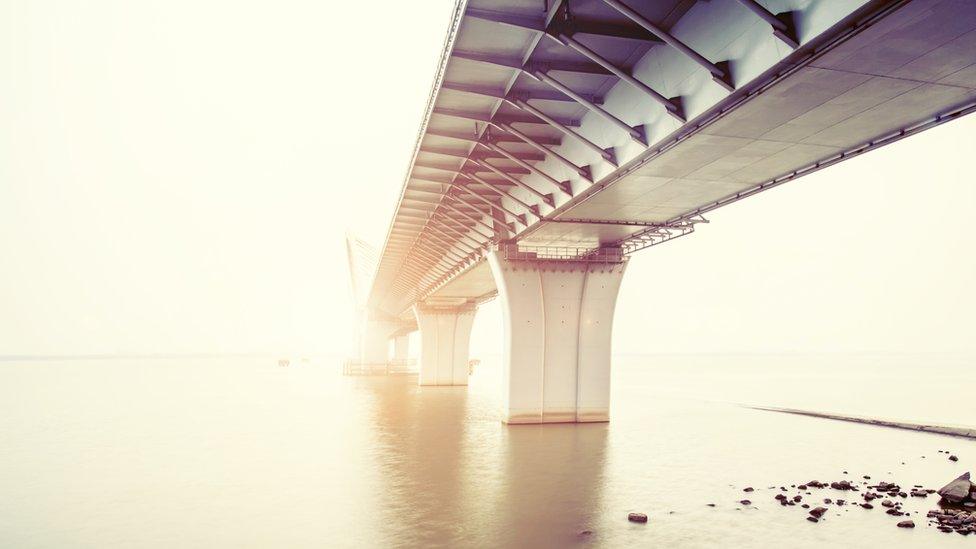
Building a bridge from Northern Ireland to Scotland is like "adding a conservatory to a leaking house", the UK's largest transport body has said.
On Monday, No 10 revealed work is under way "by a range of government officials" to look at the idea.
However the Freight Transport Association (FTA) said it was "difficult to get past the economic and practical barriers" of a £20bn-plus project.
So can the 'Boris Bridge' rise from the seas or is it dead in the water?
A live proposition
Prime Minister Boris Johnson has described the bridge as a "very interesting idea".
However, politicians in Northern Ireland have given the proposal a mixed reception.
Sinn Féin, the SDLP, Ulster Unionists and Alliance Party have all voiced scepticism.
On Friday, Northern Ireland Infrastructure Minister Nichola Mallon wrote to Transport Secretary Grant Shapps to express concern that a feasibility study had been commissioned without her department being consulted, as did Scotland's Transport Secretary Michael Matheson.
Allow X content?
This article contains content provided by X. We ask for your permission before anything is loaded, as they may be using cookies and other technologies. You may want to read X’s cookie policy, external and privacy policy, external before accepting. To view this content choose ‘accept and continue’.
Scotland's First Minister Nicola Sturgeon previously said her mind was not closed to the idea, but added that "if he [the prime minister] has got £20bn to build such a bridge going spare, that could be spent on more important priorities".
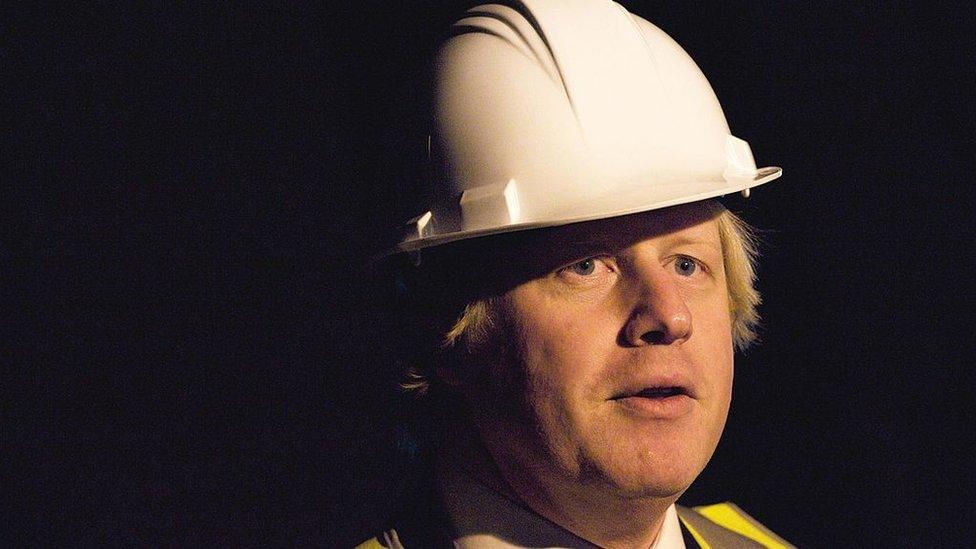
Prime Minister Boris Johnson has described the bridge as a "very interesting idea".
Taoiseach (Irish prime minister) Leo Varadkar has said he would not dismiss the idea, but insisted the UK must pay for it.
DUP MP Paul Girvan MP believes it has potential.
"Any sea link project will also bring much needed investment to coastal areas in Northern Ireland and Scotland as well as bringing major investment to road infrastructure in South Antrim and East Antrim," Mr Girvan said.
Mr Girvan also hit out at naysayers, who he said were "ideologically motivated" and "seeking to weaken Northern Ireland's place within the UK".
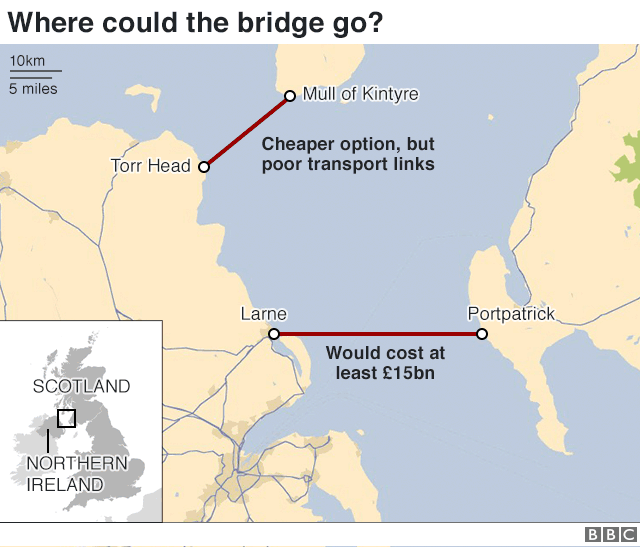

A matter of maths
One economist believes plans for the bridge are likely to "sink into oblivion".
Ulster University's Esmond Birnie insisted any benefits are unlikely to outweigh a build cost of "£20bn-plus, or even £30bn" and that "even on the most optimistic of assumptions, the sums in benefits will be less than possible cost".
He told BBC News NI that the three "quantifiables" to be looked at include a boost to NI-GB and GB-NI trade from reduced transport costs, reduced journey time via road than by sea, and the potential for increased interaction between businesses in Belfast and central Scotland.
"None of this says for sure 'don't build', and it is worth pointing out that a bridge would help the regional economy in what is one of the poorest parts of Scotland, the South West," he said.
"But it is indicative that a small amount of that project budget spent in other ways (investing in education and applied science) might well yield greater returns.

Ulster University economist Esmond Birnie believes the project will "sink into oblivion"
"I think the most likely outcome is that the Department for Transport and HM Treasury will eventually produce a report saying more or less as above, and at that point the PM will let it sink into oblivion."
Neil Gibson, EY Ireland chief economist, said that with "the critical phase of Brexit negotiations under way", the viability of an Irish Sea bridge is now "a more urgent task to focus on".
"Trade benefits are complex to measure," he said.
"There would be a number of costs to consider, including the loss of business to existing transport companies, the cost to users and the surrounding infrastructure costs needed to connect either end to the respective transport networks.
"A full cost benefit analysis would be needed to determine its value relative to the status quo and other options to enhance trade, but at this point in time it feels there are more pressing issues to resolve."
The business case
While a bridge would pose an obvious threat to the future of ferry operators, none of the main suppliers operating out of Larne wanted to comment on the prospect at this stage.
The Confederation of British Industry (CBI) and those who run Belfast Harbour felt it was "too early to say anything either way".
However, the Freight Transport Association said building a bridge would be "akin to building a conservatory on to our house while the roof is leaking".
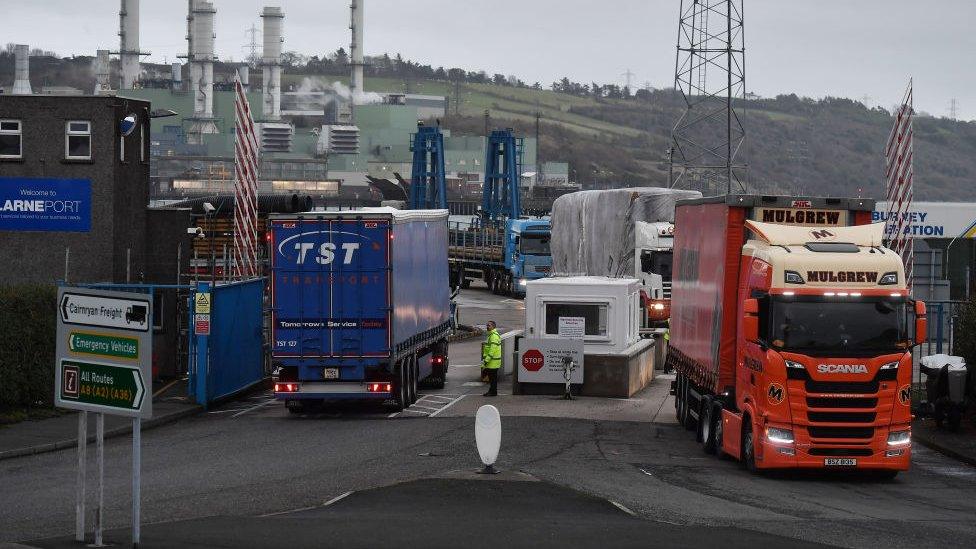
None of the ferry companies operating out of Larne port wanted to comment on the proposed bridge at this stage
Northern Ireland policy manager Seamus Leheny said: "£20bn would radically transform our infrastructure in Northern Ireland and how we move people and goods, with enough left over for health and education.
"The potential economic benefits post-Brexit are hard to define as yet.
"It could possibly make it cheaper to move goods to and from Northern Ireland although a toll would be likely and lorries would be using fuel, as well as creating an impact on drivers' hours so costs would still be there.
"This sounds great in theory but the more you analyse the concept, it's difficult to get past the economic and practical barriers. I think for some it's a bit like a child constantly being promised they'll get to go on holiday to Disneyland but inevitably it never happens."
Deep concern
If the finances for such a huge infrastructure project were not enough to cope with, there is also the small matter of Beaufort's Dyke, external - the UK's largest offshore dump site for conventional and chemical munitions after World War Two.
The deep trench lies seven miles off Portpatrick and the Ministry of Defence estimates there are 1.2 million tonnes of abandoned munitions at the bottom, in addition to two tonnes of concrete-encased drums filled with chemical and radioactive waste.
Robin Rickard, an expert in unexploded ordnance (UXO), has "significant concerns" about plans for a bridge and believes dealing with the risk could see costs spiral.
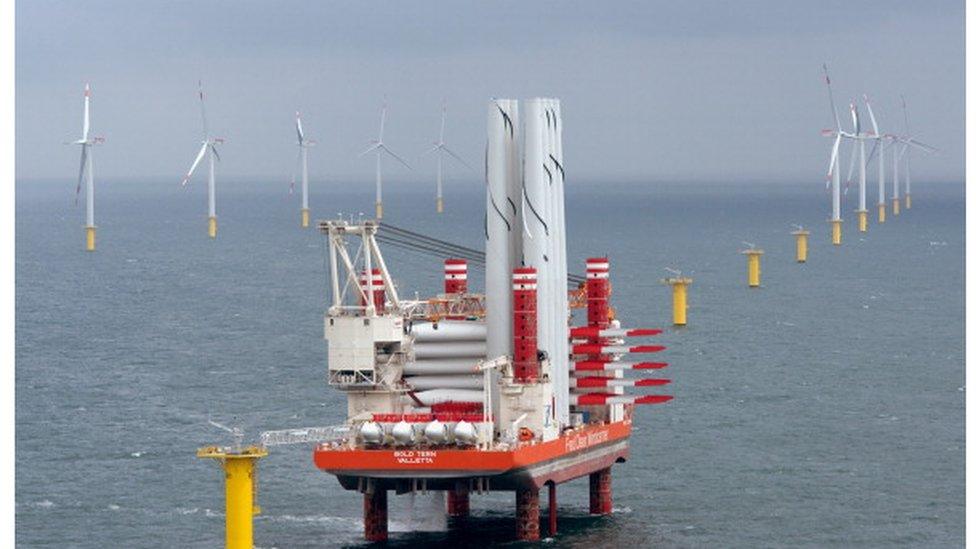
The Riffgat wind farm ran massively over budget
He cites the example of the Riffgat wind farm off the cost of Germany, which lay idle for more than a year as experts cleared munitions before cables could be laid.
By the time the job was finished, the UXO element had added a reported £100m to the bill.
"With bad experiences of cable laying through explosive sites, I would suggest the crossing would have to avoid such threats entirely or employ a floating support structure," Mr Rickard added.
Engineering consultant David Fletcher said putting bridge supports in the middle of the Beaufort Dyke would be "extremely dangerous", with works that could "potentially lead to chemical leaks which in turn could lead to significant environmental risks".
He also expressed concern that the logistics of the project could easily see costs spiral.
"Construction would be very weather dependent and the North Channel is notorious for its unpredictable winds and strong currents," he added.
"So as not to interfere with shipping, the bridge would need to be raised to a height that would provide sufficient clearance. This could be done at selected locations but this would cause navigation problems.
"A single column being damaged by shipping or terrorism could put the bridge out of action for months and could be extremely difficult to repair."
- Published22 January 2018

- Published10 March 2021
